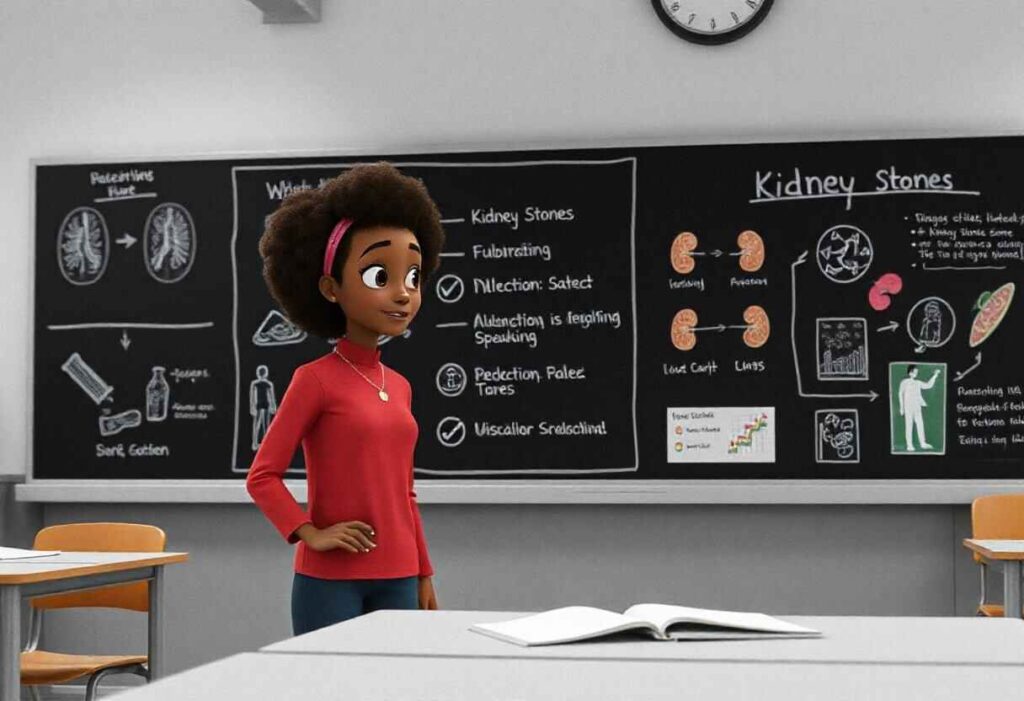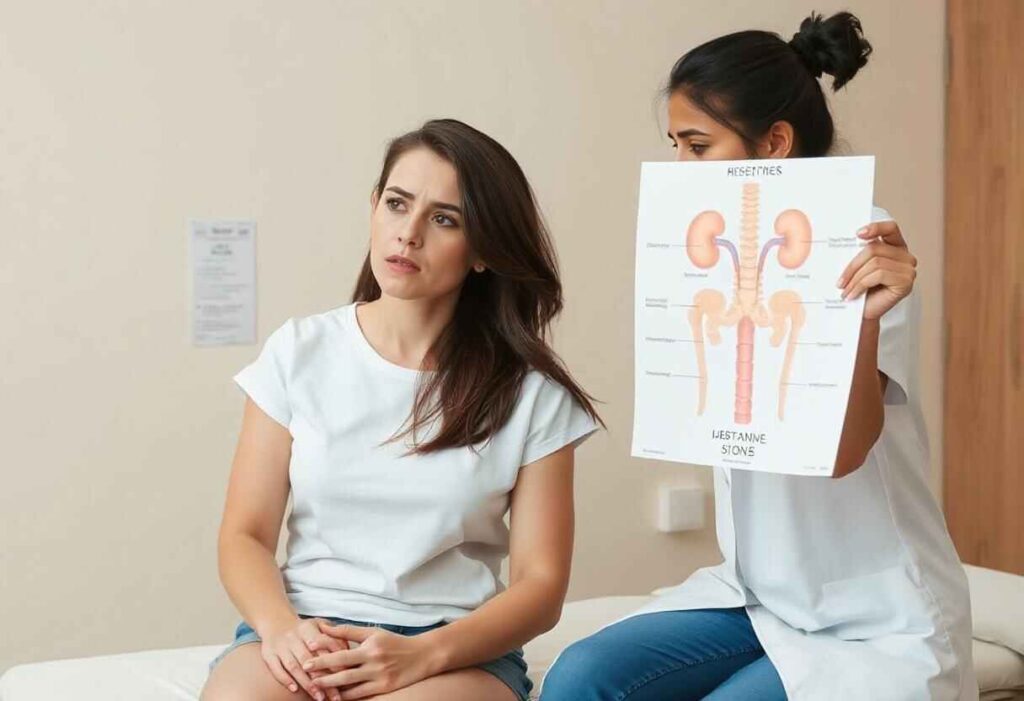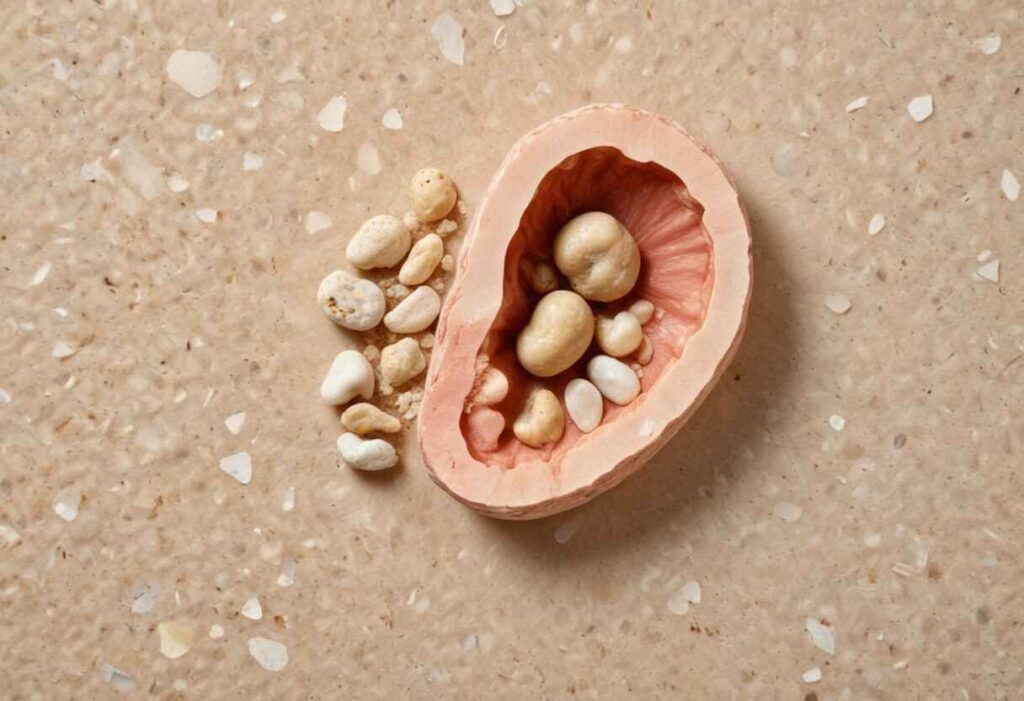Kidney stones are tiny, hard pieces that form in the kidneys from minerals and salts. They can cause different symptoms, especially when they move into the tubes that carry urine out of the body. When a kidney stone gets stuck in these tubes, it can cause a lot of pain and lead to serious health problems if not treated quickly. For women, the symptoms can sometimes be mistaken for other urinary or reproductive health issues, so it’s important to recognize the signs early.
What are Kidney Stones?
Kidney stones are hard crystals made from things like calcium, oxalate, and uric acid. They can be as small as a grain of sand or as big as a golf ball. Small stones usually pass through the urinary tract without much trouble, but larger stones can get stuck and cause blockages.
The Urethra: A Simple Guide
The urethra is a tube that carries urine from the bladder to the outside of the body. In women, the urethra is shorter than in men, which can make it easier for stones to get stuck and cause blockages.

Symptoms of Kidney Stones in the Urethra
When a kidney stone gets stuck in a woman’s urethra, it can cause various symptoms, from mild discomfort to severe pain. Spotting these signs early helps in getting timely medical help.
- Severe Pain: The most common symptom is intense pain, often sudden and sharp, in the lower abdomen, groin, or along the urethra. The pain can come in waves and change in intensity.
- Frequent Urination: Women may feel the need to urinate more often because the stone causes irritation and blockage.
- Burning Sensation During Urination: A burning feeling while urinating is common due to the stone blocking the urethra. This may be confused with an infection of the urinary tract (UTI).
- Blood in Urine (Hematuria): The stone can cause tiny cuts in the urinary tract, leading to blood in the urine, which may look pink, red, or brown.
- Difficulty Urinating: The stone might partially or fully block urine flow, making it hard to urinate and causing a sense of urgency with little or no urine coming out.
- Cloudy or Foul-Smelling Urine: Infections can develop because of the blockage, causing changes in the urine’s appearance and smell.
-
Symptom Description Location Duration Additional Notes Sharp Pain Intense, sharp pain often described as colicky or cramping. Lower Abdomen or Groin: Pain may radiate to the lower abdomen or groin. Variable: Pain can be intermittent or constant. Pain Relief: Pain may come in waves and can be severe. Painful Urination Discomfort or burning sensation during urination. Urethra: The pain is felt during or after urination. During Urination: Pain occurs throughout the process. Check for Infection: This symptom may also indicate a urinary tract infection. Frequent Urination Increased urgency and frequency of urination, often with a reduced volume. Bladder: Frequent need to urinate, sometimes with little output. Persistent: May continue until stones are treated or pass. Hydration: Drinking more water can help flush out stones. Hematuria Presence of blood in the urine, making it appear pink, red, or brown. Urine: Blood may be visible in the urine. Variable: May be intermittent or constant. Seek Medical Advice: Blood in urine can indicate stone movement or injury.
| Related: What Do Kidney Stones Look Like in the Toilet? |
Causes and Risk Factors
Several factors can make it more likely to get kidney stones, including:
- Dehydration: Not drinking enough water can make urine more concentrated, which helps stones form.
- Diet: Eating a lot of salt, sugar, and protein can lead to kidney stones.
- Obesity: Being overweight can change the acid levels in your urine, making stones more likely.
- Family History: If a family member has had kidney stones, your risk is higher due to genetics.
- Medical Conditions: Certain conditions, like hyperparathyroidism and some urinary tract infections, can increase the risk of getting kidney stones.

Diagnosis and Treatment
When symptoms suggest a kidney stone in the urethra, a healthcare provider will usually do several tests to confirm it:
- Urinalysis: To check for blood, infection, or crystals in the urine.
- Imaging Tests: Ultrasound, X-ray, or CT scan to find the stone.
- Blood Tests: To identify any conditions that might be causing the stone.
Treatment options depend on the stone’s size and location. Small stones might pass on their own with more fluids and pain relief. Larger stones may need medical help:
- Medications: To relax the ureter muscles and help pass the stone.
- Extracorporeal Shock Wave Lithotripsy (ESWL): Uses shock waves to break the stone into smaller pieces.
- Ureteroscopy: A small scope is passed through the urethra and bladder to remove the stone.
- Surgery: In rare cases, surgery may be needed to remove the stone.
| Aspect | Description | Diagnostic Methods | Treatment Options | Additional Notes |
| Diagnosis | Identifying the presence of kidney stones and their location. | Imaging Tests: Ultrasound, CT scan, X-rays. | Consult a Healthcare Provider: Diagnosis should be confirmed by a medical professional. | Follow-Up: Regular monitoring to track stone progression or recurrence. |
| Urine Tests: To check for blood or infection. | ||||
| Blood Tests: To assess kidney function and calcium levels. | ||||
| Pain Management | Managing the pain associated with kidney stones. | Medications: Pain relievers like NSAIDs or opioids. | Prescription Painkillers: For severe pain, stronger medications may be needed. | Consult Doctor: For appropriate pain management strategies. |
| Home Remedies: Applying heat or using a heating pad. | ||||
| Stone Removal | Procedures to remove or break down kidney stones. | Extracorporeal Shock Wave Lithotripsy (ESWL): Uses shock waves to break stones into smaller pieces. | Procedure Selection: Based on stone size, location, and patient health. | Post-Procedure Care: Follow-up care is crucial for recovery and to prevent complications. |
| Ureteroscopy: A thin tube is inserted to remove or break stones. | ||||
| Percutaneous Nephrolithotomy: Surgical removal of large stones through a small incision. | ||||
| Preventive Measures | Strategies to reduce the risk of future kidney stones. | Dietary Changes: Increase fluid intake, reduce sodium and oxalate-rich foods. | Lifestyle Adjustments: Regular exercise and maintaining a healthy weight. | Regular Check-Ups: Monitor kidney health and stone formation risk. |
| Medications: To manage underlying conditions and prevent stone formation. |
Prevention Kidney Stone
Preventing kidney stones involves changing your diet and lifestyle:
- Stay Hydrated: Drink plenty of water to dilute the substances that form stones.
- Eat a Balanced Diet: Limit your intake of salt, sugar, and animal protein.
- Monitor Calcium Intake: Keep calcium levels normal through your diet, as too little or too much calcium can cause stones.
- Avoid Oxalate-Rich Foods: Foods like spinach, nuts, and chocolate can contribute to stone formation, so limit these in your diet.
Conclusion
Recognizing the symptoms of a kidney stone stuck in the urethra is important for women to get medical care quickly. The pain and discomfort can be severe, but there are effective treatments available. By understanding the symptoms and taking steps to prevent kidney stones, women can reduce their risk and maintain better urinary health.

